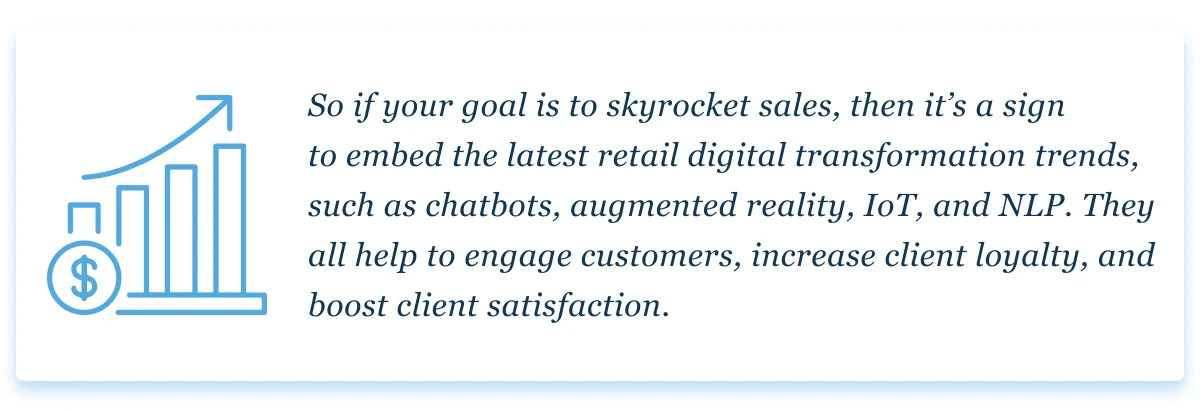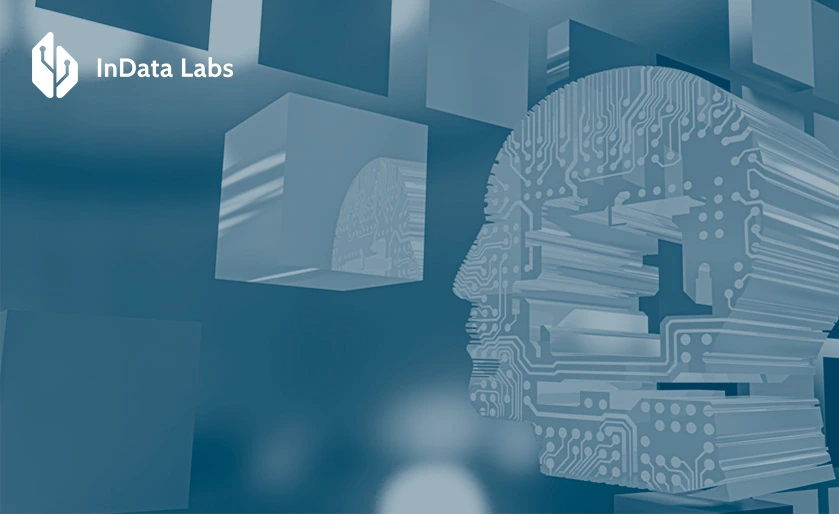As reported by Statista, digital transformation investments were $2.1 trillion this year and will increase to $3.4 trillion by 2026. These numbers mean that many businesses turned for help to digital transformation trends as they provide opportunities to adapt, evolve, and prosper. It’s no surprise as remaining viable in today’s hectic and constantly shifting corporate world now became a daily challenge. The global economy has experienced tremendous changes, the future is unforeseen, and businesses are now navigating unexplored waters. To keep their heads above the water businesses have no other choice but to recognize the ultimate need to constantly analyze and adopt transformative digital trends.
Here you can get acquainted with the latest digital transformation trends for 2023 to accelerate business processes and get to the top.
Digital transformation trends 2023
So what are they? Check the latest news of digital transformation below and find the best solution for yourself.
AI adoption
Fortune Business Insights reports: the global artificial intelligence (AI) market is projected to grow from $515.31 billion in 2023 to $2,025.12 billion by 2030, exhibiting a CAGR of 21.6%. The demand will likely maintain AI’s dominance over the upcoming years, making it a worthy investment in your business. Artificial intelligence is expected to be adopted by nearly 75% of surveyed companies, says the World Economic Forum.
Benefits: serves as an automation tool for cost savings; reduces human errors and risks connected; available 24/7; makes unbiased decisions; improves the speed of operations and provides better surveillance; offers a broad range of new capabilities and services.
Generative AI
According to McKinsey 2023 research, about 75 percent of the value that generative AI use cases could deliver falls across four areas: customer operations, marketing and sales, software engineering, and R&D. It’s also stated the total economic benefits of generative AI amounts to $6.1 trillion to $7.9 trillion annually, proving that generative AI has the potential to skyrocket your business’s revenue as well.
Benefits: reorganizes and classificates data; substantially increases labor productivity; supports interactions with customers, generates creative content for marketing and sales, drafts computer code based on natural-language prompts, and performs many other tasks.
Machine learning
As Zippia 2023 study states, 73% of business leaders believe machine learning will double productivity for their employees. Companies that adopted AI in at least one business function saw an average revenue increase of 66% within those functions. The global machine learning industry is projected to have a CAGR of 38.8% between 2022-2029, so implementing ML in business workflows has become a must.
Benefits: improves and customizes client experience; predicts consumer behavior; improves accuracy; filters email; enables mass customization; detects trends and sentiments in customer feedback and reviews; pinpoints areas for improvement; makes more informed product development decisions; detects anomalies.

Source: Unsplash
ChatGPT integration
According to a Gartner report, more than half of the respondents are utilizing some sort of conversational AI platform, such as chatbots, for customer-facing applications. By 2025, customer service organizations that embed AI in their multichannel customer engagement platform will elevate operational efficiency by 25%. Resumebulilder research says, that 1 in 4 companies have saved $75k+ with ChatGPT, and 49% of companies say they are already using ChatGPT, stating that GPT integration is now mandatory for businesses to keep up with others.
Benefits: makes up summaries; creates outlines; generates customer service emails and interview questions; improves response times; collects feedback; boosts customer engagement and reduces client requests; increases lead generation; helps with web development and A/B testing; lowers employee churn and reduces costs.
Chatbot development
84% of companies believe that AI chatbots will become more important for communication between a customer and business, according to CCW. Moreover, The Global Chatbot Market size is estimated to grow at a CAGR of 29.59% between 2022 and 2027, Technavio writes. On the ground of statistics as well as digital transformation market trends, it becomes evident that to meet the evolving customer needs, businesses will have to consider chatbot development in the near future.
Benefits: 24/7 availability; boosts customer support; cuts costs; performs various tasks; enables multi-language conversations; identifies potential customers; gathers contact information and optimizes sales teamwork.

Source: Unsplash
Large language model development
Large language models have emerged as the major game-changers among the astonishing breakthroughs in AI. These models, such as GPT-3, provide a myriad of perks that have the potential to reshape the way businesses work, communicate with their clients, and innovate. Businesses could boost their efficiency and competitiveness by harnessing the power of LLMs and generative AI to automate tasks, enhance decision-making, and gain insightful data.
Although now they’re one of the latest digital transformation trends, language models have been a part of the tech world for several years.
Benefits: improves search engines and search results; writes and moderates marketing content; ensures better customer support; processes customer feedback analysis and shares insights; optimizes SEO; generates ideas and tackles problems etc.
NLP
Fortune Business Insights: The global Natural Language Processing (NLP) market size is projected to grow from $24.10 billion in 2023 to $112.28 billion by 2030, at a CAGR of 24.6%. As investments in NLP continue to rise (the NLP market size is around $16 billion in 2022 and will reach approximately $50 billion in 2027, representing an average annual growth rate of over 25%, according to Market&Market report), it becomes crucial for business to leverage its potential.
Benefits: data management; sentiment analysis; virtual assistants; text summarization; semantic search; real-time language translation.
Enhanced customer experience
According to Superoffice statistics report, 35% of corporate leaders believe that digital transformation helps businesses better satisfy client expectations. Companies that transition digitally have more engaged consumers. And, when compared to the ordinary customer, highly engaged consumers buy 90% more frequently, spend 60% more on each buy, and have three times the yearly value. The Temkin group’s figures say that companies earning $1 billion a year earn an additional $700 million over 3 years by investing in customer experience.

Benefits: high customer retention and engagement; high client loyalty; reduced costs of service and marketing; increased brand equity.
Predictive analytics
According to research, the global market for predictive analytics solutions reached more than $12 billion in 2022 and in 2028, it might go up to $38 billion, with a CAGR of 20.4%. More and more businesses have started implementing this digital transformation trend to become long-term winners. Forecasting future events using predictive analytics is extremely useful in many different contexts. It’s just the right choice to streamline your business processes.
Benefits: forecasts consumer behavior and predicts consumer retention; determines financial trends; creates targeted marketing; makes data-driven decisions; improves operational efficiency; identifies risks and detects fraudulent use.
Business automation
A recent study showed that the market size of business process automation is expected to grow to $22.94 billion by 2027 at a CAGR of 13.1%. A survey of Global 500 companies found that leaders choosing to invest in AI and automation business tools and software solutions expect to see significant growth within the next few years. No wonder: as businesses start incorporating AI, robotic process automation takes more limelight.
Benefits: enhances business efficiency; slashes out costs; boosts accuracy and consistency; accelerates data management and analysis; improves scalability; reinforces employee morale.

Source: Unsplash
Data security
Data protection has become an executive-level concern: it can contain highly sensitive information such as personal details, financial information, and trade secrets. As a result, ensuring the security of this data has become a top priority for individuals and organizations alike. Businesses that understand this will employ proactive protection methods at the record level, as it helps enhance corporate reputation and build customer trust. And with all the latest trends in digital transformation at hand, it becomes really easy.
Benefits: protects fraud and cybercrimes; saves your resources, both time and money; prevents websites from going down; helps stay ahead of competitors.
Cloud
As the issue of cyber safety has become of most importance, more and more businesses are migrating to the cloud to guarantee that their data is safeguarded and encrypted. According to RapidScale, 94% of businesses reported they saw an improvement in security after switching to the cloud. Think about it as your own confidential and safe computer in a room full of computers, customized to your specific needs. As another plus, you just pay for the necessary speed and storage.
Benefits: enhanced security; lower costs; higher productivity and flexibility; and scalability.
Saas-as-a-service
SaaS (or cloud application service) is a software distribution methodology that is operated by an outside vendor and accessible via the Internet. Most SaaS programs do not require setup because they can be reached through a web browser. If correctly deployed, the SaaS platform is a profitable model for both clients and software suppliers. So, if you want to improve your business output and take it to the next level, SaaS is a good strategy to consider.
Benefits: cost-effective; better scalability and accessibility; high compatibility and adoption rates; no need for extensive hardware;
IoT
The market of consumer IoT is booming. Startups continue to invent new connected devices and it seems like the demand for them will only grow with time.

IoT holds immense potential in elevating customer satisfaction to new heights by offering advanced functionalities and personalized experiences. If you’re still hesitant about IoT technology, now is the time to start investigating it.
Benefits: improved efficiency, enhanced customer experience, agility; cost reduction; additional business opportunities; augments cybersecurity and identifies potential threats in real time.
Edge computing
Along with the exponential growth in cloud computing and the Internet of Things, businesses are starting to hear more and more about edge computing. Still, edge computing is an unfamiliar and untested concept for many companies. As GlobeNewswire reports, the global Edge Computing market size is projected to reach US$ 55930 million by 2028. Its advantages promote intelligence, connecting the two worlds of physical and digital in series. Edge computing helps Digital Transformation 4.0 reach its next stage through smart solutions and process advancements.
Benefits: improved performance; real-time analysis; better data security; and cost-effectiveness.
Already decided on implementing trends?
Doubtlessly, companies that have a clear digital transformation plan can outperform their rivals. Without a digital adoption strategy, a company risks becoming irrelevant and losing consumers to rivals. Furthermore, it may be unable to take full advantage of new prospects and technology, causing it to fall behind in terms of innovation. Nevertheless, considering an ever-dynamic digital landscape, setting up a digital transformation strategy might be hard as you have to track and adjust to the digital transformation trends. To minimize confusion, you can use the following tips:
Define the objectives
The core goals of a company should be related to a plan that will lead to digital transformation. This strategy should include the specific aims and objectives of the transformation, as well as the primary tools and procedures that will be implemented to accomplish them. Setting explicit goals will help everyone grasp your vision and the direction you want to take the company, assess which projects are worth investing in, and which methods are the most efficient.

Source: Unsplash
Train employees
After digital trends integration, your aim is to provide your team with tools that make adoption easier. Investing in training your personnel how to work effectively with new technologies can accelerate the process of full implementation and simplify switching to digital.
Feels like it’s too much to do on your own?
It’s much easier and less time-consuming for a business to get an AI consultation as it offers a resource-efficient approach to achieving the ultimate objectives.

Selecting an AI vendor is a long-lasting decision. So you have to examine the vendor’s monetary stability, credibility, and market longevity. The first crucial step is to select an AI vendor with expertise in AI technologies and a proven track record in driving successful digital transformation market trends initiatives.
During the consultation phase, the AI vendor conducts a comprehensive assessment of the existing business systems, processes, and data infrastructure. This assessment enables the vendor to gain a deep understanding of the unique challenges and objectives of the business. Based on this analysis, the vendor develops a bespoke AI solution that seamlessly integrates with the existing systems and effectively addresses the specific pain points faced by the business, resulting in increased efficiency and optimized outcomes.
Throughout the implementation process, the AI vendor provides valuable guidance, support, and training, ensuring a smooth transition and empowering employees to effectively utilize the AI technology. Moreover, the vendor offers ongoing support and monitoring to fine-tune and optimize the AI solution based on real-time data and feedback. This continuous improvement approach ensures that the AI solution remains aligned with the evolving needs of the business, enabling agility and adaptability in the digital transformation journey.
By leveraging AI consultation, businesses can save significant time and resources by avoiding the need for in-house AI expertise and lengthy trial-and-error processes. The tailored AI solution not only enables cost savings but also improves the overall effectiveness of the digital transformation industry trend initiative, leading to better outcomes and a higher chance of success.
To draw the line
In today’s rigorous economic climate businesses cannot afford to lose sight of the groundbreaking digital transformation latest news. Raising profitability, getting an edge over your rivals, and running your organization at optimal efficiency have now become essential.
The top new technology trends equip businesses with a road map for surviving turbulent times, being profitable, and prospering in the age of data. By using the most recent innovations, superior mobility, enhancing customer experience, unleashing new revenue streams, and following the top trends in digital transformation, businesses can position themselves at the forefront of innovation and secure their place in an ever-more competitive market.
The time has come to embark on the digital transformation journey, and those who adapt and evolve will emerge as tomorrow’s leaders.
Adapt latest tech trends for your business
Reshape the future of your business by integrating innovation into your business. Contact us for a consultation today, and our specialist will reach out to you for a consultation.
FAQ
-
Gartner predicts the top 3 key trends to be:
- Generative AI;
- AI Trust, Risk and Security Management (TRiSM);
- AI-Augmented Development.
-
It’s the realization of the digital transformation of the field, enabling real-time decision-making, and enhanced productivity and agility.
-
- Pre-planning. The key is to align your project goals with the existing corporate goals.
- Resourcing. A solid resource plan is an offshoot of the overall strategy that is critical to project success.
- Business Visioning. Once you’ve agreed on a common vision for the end outcome, you may specify the capabilities and workflows that will be included in that future state.
- Project scope definition.
- Data migration. You have to be able to retire all of your legacy systems.
-
- Process transformation is a strategic initiative aimed at improving the efficiency and effectiveness of a company’s operations;
- Business Model Transformation is the process of altering the fundamental way a company operates and delivers value to customers;
- Domain Transformation, used for entering new markets;
- Organizational Digital Transformation, the process of driving significant changes in the culture, and mindset to fully embrace digital transformation trends.



